
BACK STEP TALKS
SERIES III ISSUE 3 APRIL 2024
Life Safety Initiative #9
Over the past decade, 2013 – 2023,
on average nearly 100 firefighters are
killed in the United States each year.
Firefighter injuries are estimated at
around 61,000 per year because not
every injury is reported or meets the
criteria of a reportable injury. And
the fire service has no idea of how
many near-misses (or near-hits)
occur each year even though there
was a firefighter near- miss website
established to record these.
The only way we can learn from our
mistakes is to perform a complete
investigation for every near-miss,
significant injury, or fatality. For the
latest Firefighter Injury report (2022)
please go to
https://www.nfpa.org/
education-and-research/research/nfpa
-research/fire-statistical-reports/
firefighter-injuries-in-the-united-
states.
In previous issues of Back Step
Talks, we have provided extensive
coverage of the line-of-duty deaths
of Nathan Flynn (Howard County,
2018) and Joshua Laird (Frederick
County, 2021). We applaud the
efforts of both Howard County
Department of Fire and Rescue
Services, and the Frederick County
Division of Fire and Rescue Services
for conducting a thorough
investigation of these LODD’s,
making life saving changes to their
operational procedures, and sharing
that information so that other
departments can learn from these
tragic events.
In this issue, we visit LODD and
injury reporting systems with an
encouragement for every department
to utilize these resources to learn
from others and to share their own
experiences so that everyone learns.
We also revisit some of the key
issues that are killing our firefighters
and what actions are necessary to
reduce injuries and deaths. Please
take the time to read these articles
and share with others.
written by Dave Reid
Pawtucket FD firefighter survives near-miss roof collapse.
Photo Credit: Tom Camody, Northeast Fire Photos
Firefighter Life Safety
Initiative #9: Thoroughly
investigate all firefighter
fatalities, injuries and near
misses.
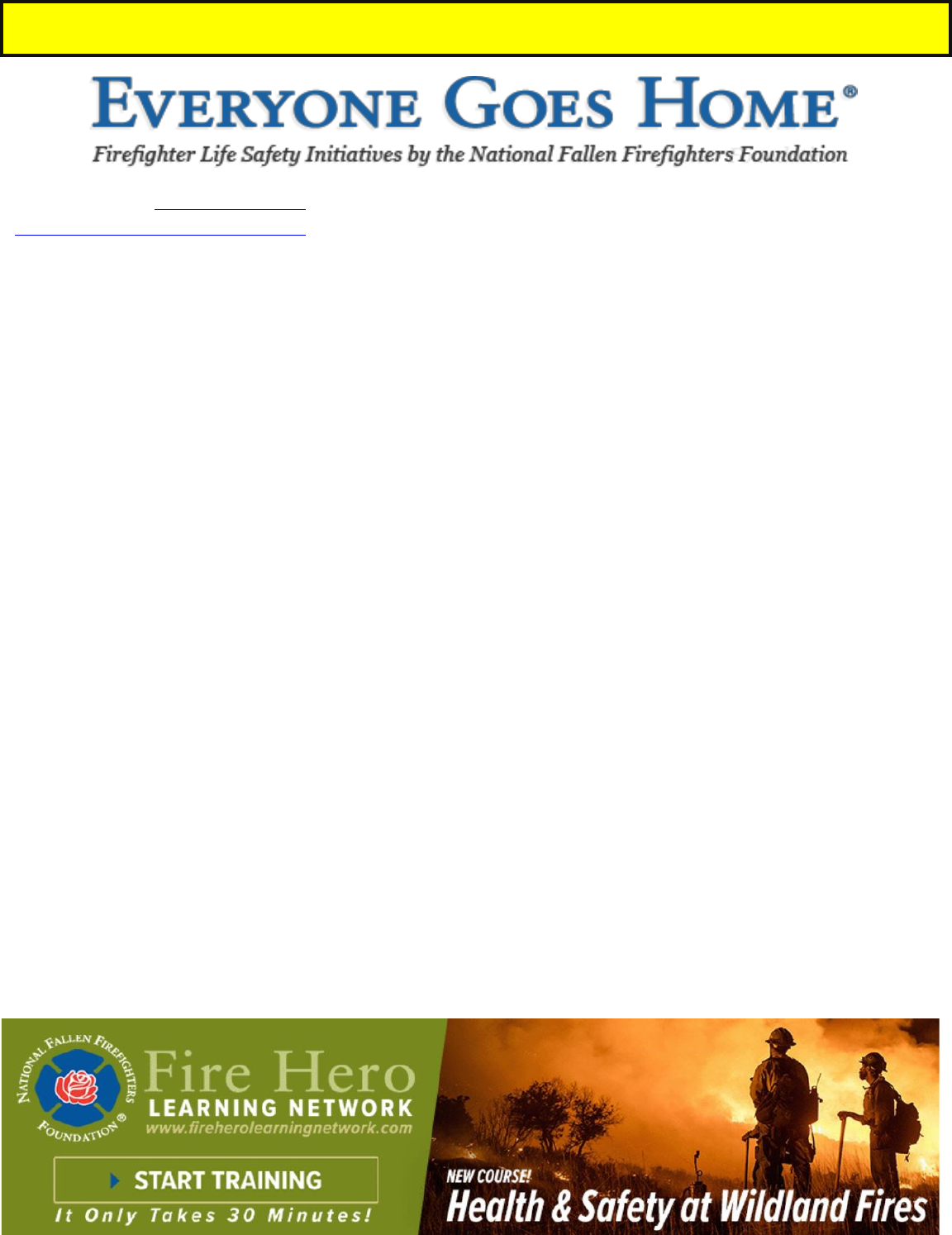
Everyone Goes Home – More Than Just a Cute Slogan
When the National Fallen
Firefighters Foundation (NFFF)
hosted the first Firefighter Life
Safety Summit in March 2004, in
Tampa, Florida, more than 200 fire
service representatives convened to
identify the means of reducing
firefighter line-of-duty deaths
(LODDs) and line-of-duty injuries
(LODI’s). Some of the questions
asked were:
- What policies or procedures
need to be changed or
enhanced?
- What changes in equipment
need to be considered?
- What additional training
should firefighters have to
be safe?
Two major outcomes of the Tampa
summit were: the development of
the 16 Firefighter Life Safety
Initiatives, and the inauguration of
the Everyone Goes Home program.
The 16 Firefighter Life Safety
Initiatives are intended to serve as a
guide for departments to reduce
LODDs and LODIs. In this issue of
Back Step Talks, and every
preceding issue, we have focused on
one or more of the Life Safety
Initiatives with information that you
can use to improve safety in your
department.
The Everyone Goes Home program
provides an educational platform for
departments to use in implementing
the 16 Firefighter Life Safety
Initiatives. The program provides
free training, resources, and
programs to help departments
reduce preventable firefighter line-
of-duty deaths and injuries.
Training programs from the
Everyone Goes Home program can
be accessed through the FireHero
Learning Network -> Training
Firefighters | Fire Hero Learning
Network The learning network
contains 24 on-line training
programs that can be completed at
your leisure while sitting at home or
while on-duty.
To build a foundation for
understanding the 16 Firefighter
Life Safety Initiatives, every
department is encouraged to have
their members complete the
“Courage to Be Safe” training
program. This training can be done
in either an on-line format or a
classroom delivery.
Through the NFFF State Advocate
program, in-person training can be
provided at a department level that
allows a deeper concentration on
changing the safety culture of the
fire service. The MFCA Health and
Safety Committee Chairman, David
Lewis, is a NFFF Advocate and can
assist with bring these training
programs to your department.
By adopting the 16 Firefighter Life
Safety Initiatives in every
department and utilizing the
resources and training offered by the
Everyone Goes Home program, we
can reduce LODDs and LODIs and
truly live up to the slogan
“Everyone Goes Home”.
Everyone Goes Home resources and
information can be accessed via
Everyone Goes Home - Firefighter
Life Safety Initiatives
Written by David Lewis
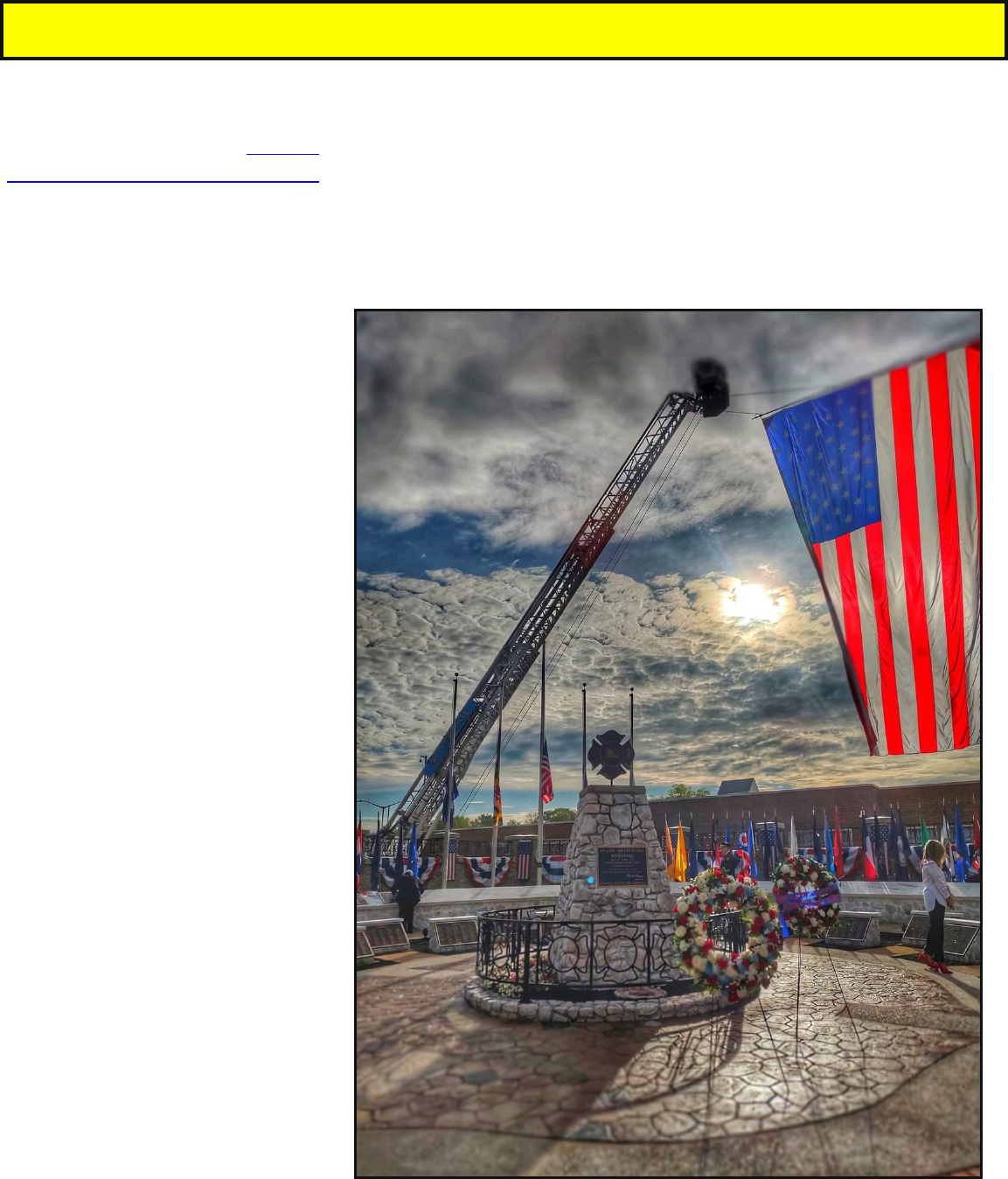
National Fallen Firefighters Memorial Weekend, May 4
th
& 5
th
, 2024
During the weekend of May 4
th
&
5
th
, the Nation’s firefighters will
gather on the campus of the
National
Emergency Training Center (NETC)
in Emmittsburg to pay tribute to 91
firefighters that died in 2023 and
135 firefighters that died in previous
years. Among these firefighters are
19 having died from post 9/11
illness. The following Maryland
firefighters will have their names
added to the Memorial Wall during
the weekend:
· Firefighter Brice Trossbach,
Naval District Washington Fire
& Emergency Services (2023)
· Firefighter Rodney Pitts III,
Baltimore City Fire Department
(2023)
· Captain Dillon Rinaldo,
Baltimore City Fire Department
(2023)
· Battalion Chief Christopher
Morlan, Frederick County
Division of Fire & Rescue
Services (2021)
· Firefighter Henry Eckhardt, Jr.,
Reisterstown Volunteer Fire
Company (2021)
· Firefighter/EMT Bryan
Hamilton, Naval District
Washington Fire & Emergency
Services (2021)
· Firefighter Mark Fisher, Jr.,
Montgomery County Fire &
Rescue Services (2014)
Several thousand firefighters will
volunteer their time to support the
fallen’s families. Family escorts will
guide and support the families while
at the NETC. Honor Guard and
Pipes & Drums will render honors to
the fallen while a team of behind the
scene staff will feed the families and
ensure everything runs smoothly.
Representatives from the Maryland
Fire Chiefs Association (MFCA)
will be resident at the host hotels to
provide assistance to the survivor
families with transportation and
other needs. Both Saturday evenings
and Sunday’s ceremonies are
streamed live on www.firehero.org
and Sunday’s ceremony is open to
the public.
written by Dave Reid
National Fallen Firefighters Memorial Emmitsburg, MD
Photo Credit: Lt. David Bullard Columbia County Fire & Rescue, GA

What’s Killing Firefighters—5 Factors We Can Control
First Responder Center for Excellence
Firefighting has always been a
dangerous job. But our perception of
the danger doesn’t always align with
reality. Put another way: What’s
killing most of us isn’t fires or
explosions or technical rescue
operations gone wrong. Too often,
what’s killing us is our failure to
take steps that are entirely our
responsibility.
Recently I had the opportunity to
attend a forceful program on
firefighter health and wellness titled,
appropriately, “What Is Killing Us?”
This one-day program was created
and run by the Loveland-Symmes
(OH) Fire Department and was
emceed by Chief Tim Sendelbach of
the Loveland (CO) Fire Rescue
Authority. The speakers included:
· Dr. Sara Jahnke, director
and a senior scientist with
the
Center for Fire, Rescue &
EMS Health Research
at the
National Development &
Research Institutes
· Chief Bryan Frieders, CEO
and president of
the Firefighter Cancer
Support Network
· Ret.
Chief Patrick J.
Kenny
, international speaker
and author of Taking the
Cape Off: How to Lead
Through Mental Illness,
Unimaginable Grief and
Loss
· Dr. Kenneth Fent, team
lead on the
CDC/NIOSH
National Firefighter Registry
· Dr. James J. Augustine, a
medical director with fire
and rescue agencies in
Georgia, Florida and Ohio,
and a member of the EMS
Eagles Global Alliance
.
There’s a lot to share from this
packed day of presentations, but
let’s focus on five key themes that
emerged as factors contributing to a
health and wellness crisis in the fire
service — yet largely preventable.
#1: We’re afraid to talk
about firefighter health
and wellness.
The fire service has come a long
way in addressing
fitness, nutrition
and illness and injury prevention
,
but many of us are still afraid to
have open, honest conversations
about our health. How many
firefighters do you know who won’t
go beyond minimum-required
medical testing because they’d
“rather not know” or they’re worried
a diagnosis will put them on light
duty? How many officers are
reluctant to confront someone on
their crew who they know is
struggling with cardio
fitness,
alcohol use, or even just
working a second job to the point of
fatigue?
We must be willing to talk honestly
with our medical professionals about
our habits and our risks. And we
must work to create a culture where
medical issues aren’t shameful and
ignoring them isn’t glorified.
#2: We’re failing to take
personal responsibility for
what’s killing us.
When we’re not hiding from the
medical issues, we’re often
consciously ignoring them.
Firefighters have a deep fatalistic
streak. That’s not surprising, and in
fact it may help us cope with the
trauma of the job. But it works
against us when there are
health and
wellness issues
well within our
control.
Dr. Jahnke, a leader in identifying
behaviors that lead to firefighter
death, stressed that we each own our
health and wellness choices.
Specifically, she mentioned the need
to understand how vital good sleep
is to our health. The book Why We
Sleep by Matthew Walker, PhD, was
mentioned by several speakers as
required reading for all firefighters.
Beyond sleep, Dr. Jahnke laid out
the factors that are right in front of
us yet seem to elude capture. Really,
how many times will we have to
hear about getting a full
cardiopulmonary work-up so we
have a baseline and then setting
goals necessary for our survival?

What’s Killing Firefighters—5 Factors We Can Control
Other factors include:
· Getting to our target weight
· Achieving cardiovascular
fitness
· Using alcohol responsibly
· Eliminating tobacco
· Establishing work-life
balance
Going further, Dr. Jahnke
emphasized how much our negative
and positive health and wellness
behaviors impact those we lead, our
families and our friends.
#3: We’re not doing
enough to reduce our
cancer risk.
Chief Frieders shared several real-
life examples of firefighters lost to
occupational cancer in their 20s and
30s. These are cancers the general
population doesn’t usually have to
worry about until much later in life.
On an intellectual level, we all
know cancer is a health crisis in the
fire service. But Chief Frieders
emphasized that we’re not taking
that academic knowledge and
converting it to action. Every
department needs comprehensive
policies on turnout cleaning and
storage, required use of SCBA and
PPE, and understanding that the
IDLH environment exists during
overhaul.
But it’s not just about having the
policies. It’s about being a strong
enough leader to train on and
enforce those policies. As a
certified incident safety officer, I
took Chief Frieders’ message to
heart. When an ISO sees a ladder
truck about to tangle with live
wires, an IC setting an operation
that fails to consider flow path, or a
firefighter failing to take burn time
into account before going through a
door, the ISO notifies the IC, or
physically restrains the firefighter,
and calls a stop to the operation.
ISOs must have the same
awareness, and not hesitate to exert
their fireground authority, when it
comes to practices like strict use of
SCBA during all phases of interior
work, clean cab practices, on-scene
hose-down, and mandatory gear
washing after certain operations.
What kills us doesn’t always
happen in a split second. It happens
over time. It’s up to department
leaders, oftentimes, to save our
members from themselves.
I also can’t overemphasize the
valuable work that the
Firefighter
Cancer Support Network
performs.
Every probie, firefighter, line
officer and chief should be aware
of the information the network
provides on cancer prevention and
treatment, including good policy
and practice, expert advice for
those who are diagnosed, guidance
for how firefighters can assist a
brother or sister firefighter facing a
cancer diagnosis, and available
resources and referrals.
Another essential tool for fighting
cancer in the fire service is better
data collection and reporting. Dr.
Fent leads the
CDC/NIOSH
National Firefighter Registry
,
which was designed to monitor
occupational risk factors and cancer
outcomes among U.S. firefighters.
Every firefighter should participate
(testing has begun and the open
enrollment is planned in the fall).
The system will protect all data,
privacy, and maintain participant
confidentiality; no firefighter
should worry that information
provided can be tracked back to
them.
#4: We’re pretending
COVID is over.
It’s impossible to talk about what’s
killing firefighters over the past two
years and not talk about COVID.
More than half of line-of-duty
deaths in 2020 were
attributed to
COVID
. Further, many firefighters
who survived the disease may have
symptoms of long COVID, which
can contribute to other health risks.
At the time of the conference,
hospitalizations and deaths were
trending down, but since then, they
have started to pick up again.
Addressing the current wave, Dr.
Augustine advises that there is
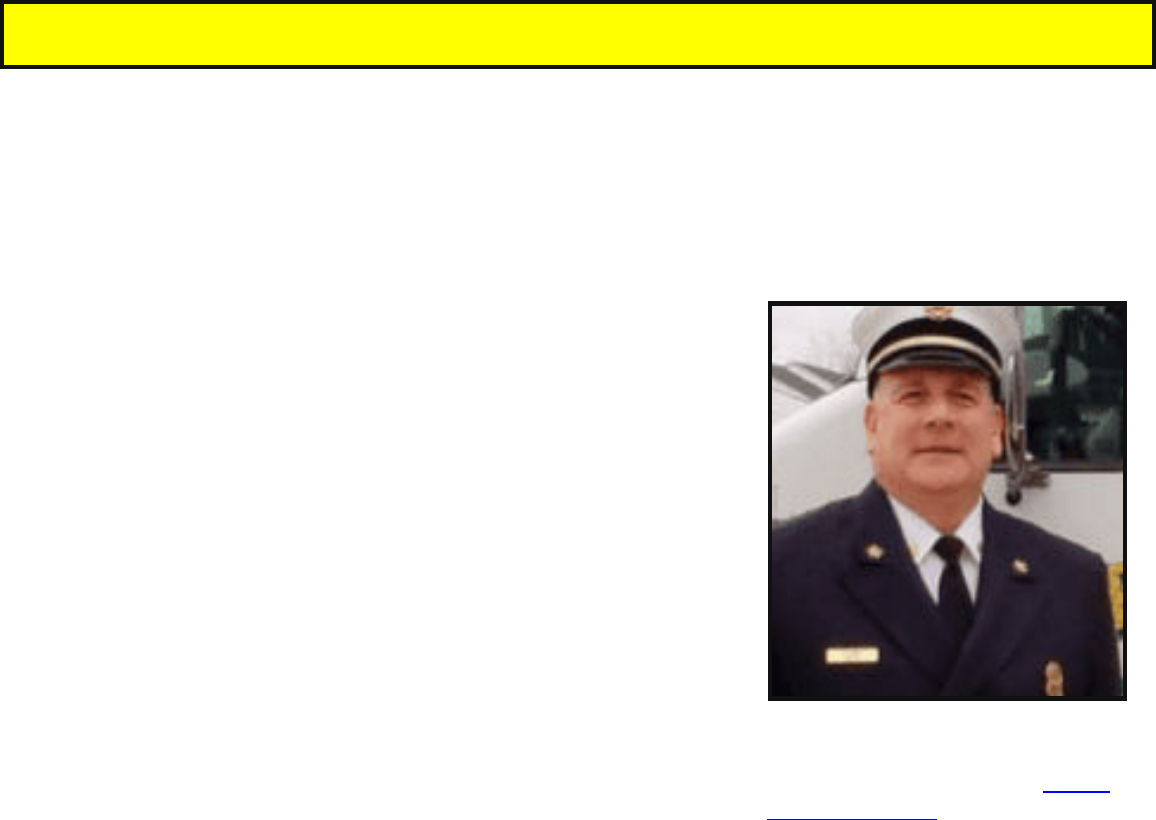
What’s Killing Firefighters—5 Factors We Can Control
greater susceptibility to serious
impact among seniors and the
unvaccinated and that, while
greater numbers of vaccinated and
boosted individuals may get one of
the variants, the effects will be far
less severe. He also notes that
because we were isolated for an
extended period and now find
ourselves going out much more, we
are experiencing an immunity gap
with regard to other illnesses and
infections. For example, Influenza
A is occurring with greater
frequency, even though we would
normally be coming out of flu
season. The bottom line?
Responders should maintain
COVID PPE practices based on
local conditions.
Dr. Augustine provides regular
COVID updates on the
Center for
Fire, Rescue & EMS Health
esearch Facebook page. I
encourage you to tune in for
practical, up-to-date information
that’s provided in layperson’s
terms.
#5: We’re hiding behind
a “cape” that won’t allow
us to ask for help.
Drawing on his personal family
tragedies, including the loss of his
son to mental illness, Chief Kenny
gave the most emotionally stirring
presentation I have ever heard at a
firefighter conference. While his
story is unique, his message applies
to all firefighters. The personality
traits and self-image that make us
great firefighters can also work
against our relationships with
family, friends and other
department members. Chief Kenny
uses the cape as a metaphor — it’s
the part of us that struggles to
reconcile being a “hero” with the
understanding that sometimes we
can’t save everyone; we can’t make
everything OK.
It’s OK to need
help
. By taking the cape off, we
protect our physical and behavioral
health, bring ourselves closer to
those who love us, and strengthen
the bonds we have with friends and
our crews.
Wrapping It Up
With the data and information
available to us today, we have a
tremendous opportunity to
recognize and acknowledge the
factors that interfere with our
physical and behavioral health. We
have the tools to turn poor health
choices into good ones. We can
learn to spot warning indicators in
ourselves and others and access the
strength in ourselves to change
behavior or call on outside
resources without fear.
Throughout the “What Is Killing
Us?” program, participants
discussed the perceived stigma
associated with asking for help.
But rather than using this as an
excuse, presenters and attendees
concluded the only stigma is a self-
imposed one. Enforcing good
cancer prevention policies,
practicing heart healthy habits at
home and at the station, and
recognizing when we need help
and seeking that help — it’s all
within our control.
Article written by Scott Eskwitt.
Reprinted with permission
from Lexipol,
https://
www.lexipol.com. Lexipol provides
policies, online training, and
wellness resources to public safety
and local government
professionals.
Scott Eskwitt is the former director
of fire policy and training content
for Lexipol. He previously served
as chief of the Fair Haven (N.J.)
Fire Department, and was a
member of the Fair Haven First
Aid Squad and the Red Bank (N.J.)
Fire Department. Eskwitt is an
attorney and has spent his legal
career advising municipalities and
fire departments on risk
management, human resources and
labor relations issues. His
undergraduate degree in Industrial
& Labor Relations was received
from Cornell University and his
law degree from SUNY Law at
Buffalo.

Are You Prepared for a Line of Duty Death?
No one wants to experience a Line
of Duty Death; however, we know
that they can happen at any time.
And now that there are more
categories covered besides being
killed in the line of duty or dying
from a medical emergency at or
within twenty-four hours of a call.
The Federal Department of Justice
Public Safety Officer’s benefits
also cover some cancers and
suicides. At the present time the
Maryland State Firemen’s
Association Trustees coverage does
not include cancer or suicide
deaths. However, Maryland
Workman Compensation laws
cover some cancers with
stipulations.
So, how do we prepare ourselves
for a Line of Duty Death?
1. When onboarding a new
member have them complete a
PSOB Designation of
Beneficiary Form and have it on
file at the station.
This form be found at
PSOB
Designee Form-11-11-13.pdf
2. Have a copy of the members
birth certificate on file.
3. Have a copy of the members
marriage license, or divorce
decree(s).
4. Have copies of their children(s)
birth certificates, or adoption
papers.
5. Have the member complete an
Emergency Contact form and
keep it on file (readily
available).
Make sure it includes spouses
place of work incase
notification needs to be made.
6. Copy of a Military Form DD-
214. Documenting their military
service.
7. Keep good training records on
each member. Now that the
Federal PSOB pays LODD
benefits for firefighters in
training make sure that they
were authorized to be enrolled
in the class.
8. Ensure that the member has
passed an entry level physical.
9. Have the member complete a
form “In Case of Death.” This
form would be used by the
department so they would know
what the deceased would want
to be done in case they died.
10. Encourage your membership to
use the “Wills for Heroes”
program from the MSFA. This
is a no cost way to ensure that
your final wishes are carried
out.
11. Take annual pictures of
members in uniform. These
pictures can be used for
multiple things.
12. Have your Chaplain trained so
they will now what to do.
Firefighters and EMTs are
trained to do their jobs. The
person filling the role of
Chaplain needs to be trained as
well.
So, what do we do if we experience
a LODD?
1. Call the National Fallen
Firefighters Foundation 866-
736-5868. The Maryland Local
Assistance State Team
Coordinator will contact you
immediately. The Maryland
L.A.S.T. is made up of
volunteer from across the state
of Maryland and has a large
number of resources to handle a
LODD.
2. Contact one of the Maryland
State Firemen’s Association
Trustees. Paperwork must be
completed within 90 days of the
death for benefits to be
considered. The Trustees have a
Procedural Guide on the MSFA
website that will give you the
detailed information you need
to apply for benefits from the
MSFA.
3. Maryland Department of Public
Safety and Correctional
Services, Office of the
Secretary at 410-585- 3728.
4. Each County/City has their own
benefits, so you will need to
find out what they are and how
to apply for them.
Many jurisdictions have memorials
to honor the fallen heroes, the fallen
will have their name put on the
Maryland Fire and Rescue
Memorial in Annapolis. Fallen
Firefighters will have their name
added to the National Fallen
Firefighters Memorial in
Emmitsburg, MD. Fallen EMTs
and Paramedics will have their
name added to the National EMS
Memorial Foundation (physical
memorial pending).
Written by John Long, Jr.
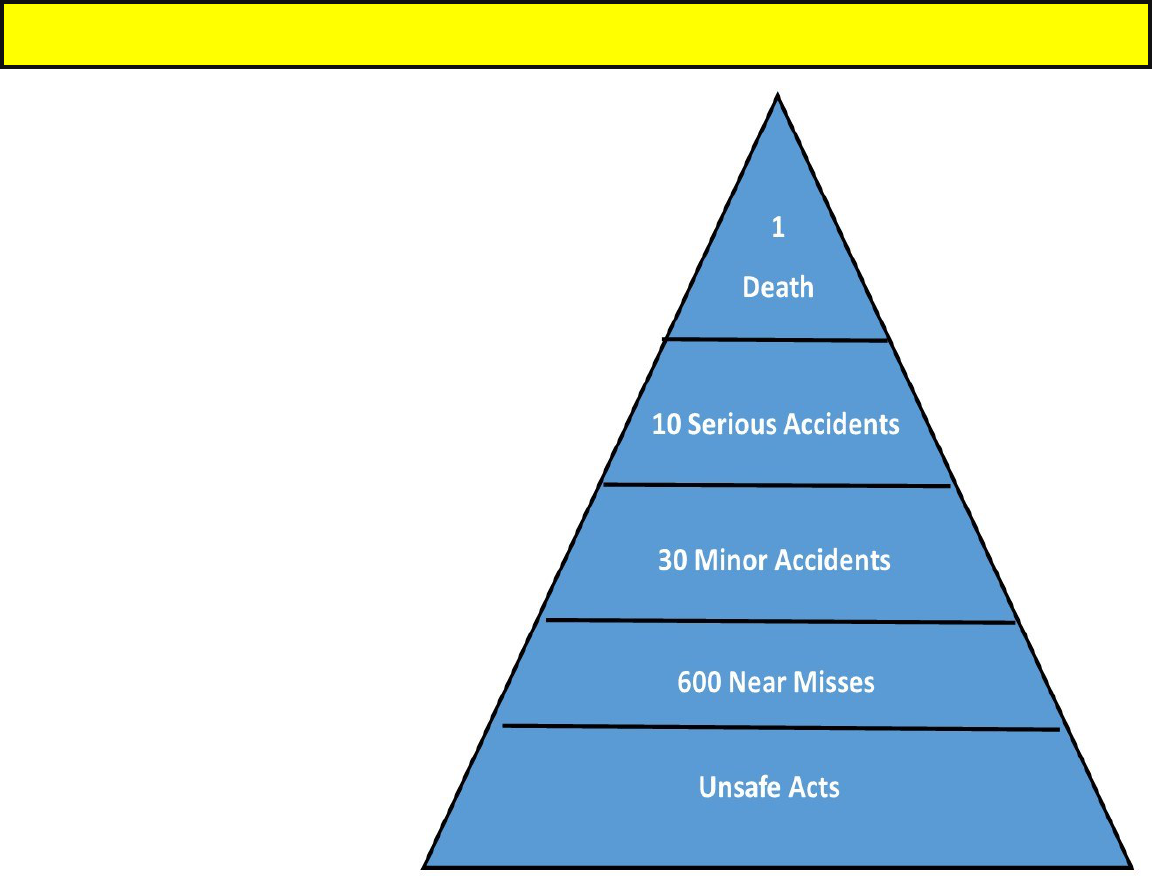
Close Calls/Near Miss – A Learning Opportunity
The question really is what is Near
Miss Reporting? According to a UK
Health and Safety Executive who
states this as “an event, including
dangerous occurrences, not causing
harm, but which has the potential of
cause injury or ill health.”1 The
management of near misses should
be important within the fire and
EMS services. The Secret List an
independent newsletter started by
Chief Billy Goldfeder in 1998 that
has evolved to
FirefighterCloseCalls.com has
become the iconic method for near
miss reporting.2 Ideally, near misses
should also be reported within a
locally established framework within
the health and safety team of each
organization.
Accident pyramids as a basis for
fire service safety.
Near misses and unsafe acts form
the lower segments of what is
known as the
“Accident Triangle”,
from the 1960’s, which is based on
the original Henrich Model from the
1930’s. The theory is based accident
prevention – that the number of near
misses (unsafe acts) is reduced then
the potential for real injury or death
will shrink. As we know the
severity of near misses within the
Fire/EMS service is enormous.
Because of this factor Health &
Safety Officers need to Identify
hazards within risk assessments,
implement safety measures and raise
awareness in training. It is
imperative for all members of the
Fire/EMS service to be aware of
hazards and how to address them.
Vigilance for potential hazards
EMS Calls, Structure Fires, Motor
Vehicle Collisions, Special
Operations all have unique
hazardous environments which the
Fire/EMS service face every day.
Staying vigilant to the potential
hidden hazards, risks and
acknowledging of near misses are all
part of the accident prevention
process. The fact that the operation
was run hazardously, SOG’s not
followed, outside factor are signs
that the next time a real accident
could occur if proactive measures
are not taken. Near Misses are the
opportunity for Officers, Firefighters
and EMS professionals to take the
opportunity to learn and implement
improvements to prevent a
reoccurrence of a hazardous
scenario. An example is the
Wicomico County Fire Chiefs
Association and the Wicomico
County Emergency Management
have implemented additional
measures to ensure safety on the
roadways by changing dispatch
procedures on certain roadways.
This was implemented because of
the increase of near misses within
the county while operating on
roadways at 50 M.P.H. and greater.

Close Calls/Near Miss – A Learning Opportunity
This open dialogue within the
association gave a feeling of
involvement and a safer response
solution was created.
Near-Miss Reporting a Positive
Culture
It is a moral obligation to report
near-misses to improve operations
creating a safer work environment.
The problem is the fear of
punishment, or retaliation for a near
miss report, peer pressure, concern
about record and reputation.
Leadership needs to stress the
importance of reporting the near-
miss incident and create a positive
culture and staff feels free to report
these occurrences. Everyone can
make a mistake, no matter how well
trained or experience on the job.
The fact that an accident was close
to happening indicates, in most
cases, a human factor contributed to
the incident. Admitting a fault can
be very stressful and intimidating in
a culture as the Fire/EMS service.
This is another human factor of
safety management which some
organizations may need to address.
The fire service mut be encouraged
and the leadership approachable
regarding reports of near misses.
The reporting process must be
designed with a positive learning
opportunity for all objectives, to
gain the trust and confidence of the
staff.
Systematic Process for near-miss
reporting
Another step to get staff to report
near misses is to make the process
itself easy to follow and not time
consuming. Near-miss reporting is
usually completed on a self-
explanatory form. Remember to
keep this simple, clear and ask for
the critical information. Some
examples of questions to ask:
Location, date and time of near-
miss, should operation had stopped
immediately or paused because of
near-miss Yes or No, Suggestions
for improvement, basic description
of incident, type of near-miss;
unsafety act, unsafe equipment.
It should be clear in a SOG where
these forms are kept and how to
deposit them for review. If in a
digital form the link and processing
procedure should be provided.
Furthermore, the organization must
prove a positive culture by
including follow up communication
in staff training or meetings. Staff
will not report if they believe
management is not looking and
acting on forms completed.
Depending on reporting processes
and internal regulations near-miss
reporting can be Anonymous vs no
anonymous. Repeat near misses
may identify a shift issue, a process
change, further training which may
eliminate the near-misses or future
accident or injury.
Awareness, training and active
participation
Near miss training should become
part of your organizations culture
just like PPE training, CPR, Hose
Line Advancement or pump
operations. Explaining what a near
miss is and providing examples is
the first step. Highlighting past
occurrences and openly discussing
issues will help eliminate hazards
and operational risks while
improving safety while in the
station or operating at an incident.
Summary
Near Miss reporting has been a
slow cultural shift since 1998 with
Chief Goldfeder started the Secret
List. The fire and EMS service has
slowly picked up the concept that
this reporting is a Learning
Opportunity that increases safety
and yet improves operations.
Leadership needs to remember this
reporting regardless of Anonymous
or Non-Anonymous is for the
betterment of the organization and
should be treated as such with no
punishment or retaliation assigned.
Leadership needs to read and take
action on near misses so staff in the
field understand the message has
been received. The process for
reporting needs to be simple and
seamless to get buy in from the
firefighters and EMS providers
engaging in these activities. Lastly
this change in culture starts in the
indoctrination of new staff just like
Firefighter 1 or EMT-B class.
Written by Dave Black
Firefighter Close Calls
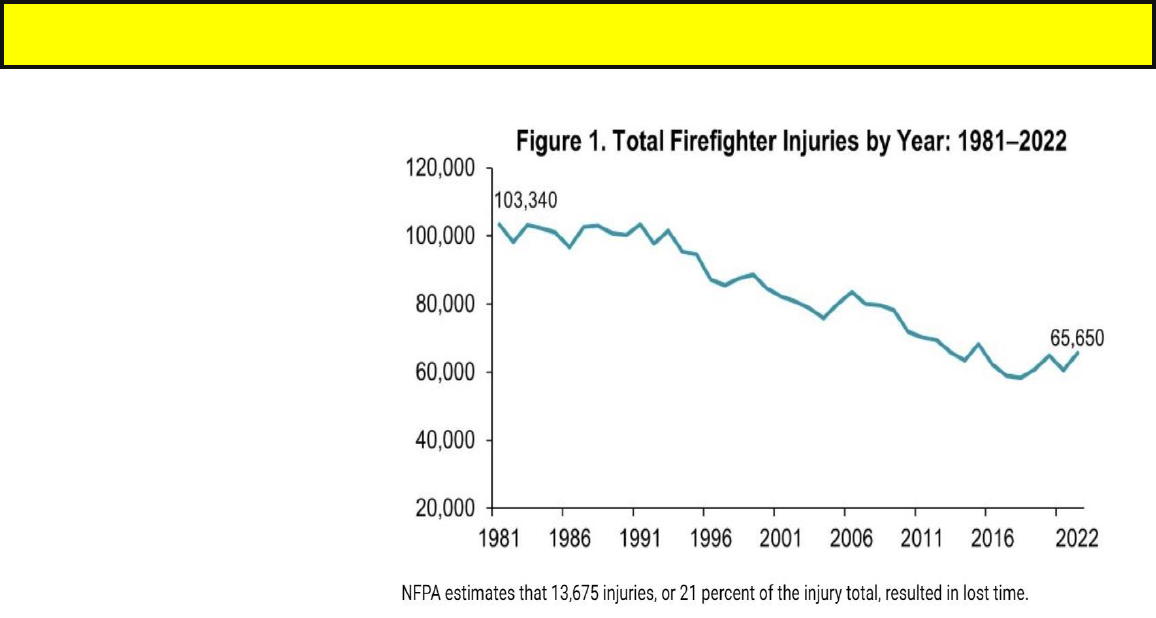
Just Culture: An Organizational Paradigm Shift for Near-Miss Reporting
According to data published by the
National Fire Protection Association
(NFPA) in December 2023, there
were over 65,000 line of duty
injuries and 96 line of duty deaths in
2022. While these numbers are
received through official reporting
channels, there is undoubtedly un-
reported events that have resulted in
injury. Furthermore, it is safe to
assume there are even more events
that go un-reported that did not result
in injury or death but had a
significant probability to result in
injury or death had the event
unfolded differently. The fire
service collectively refers to those
events as “near misses.” Near
misses are not mandatory reporting
events for most departments so it is
difficult to quantify their prevalence
in today’s fire service.
Many factors may contribute to why
these events are not voluntarily
reported but organizational culture
may play a role. Most people who
have been in the fire service for any
length of time can think instantly
think of superior officers they would
feel comfortable reporting issues to.
They can also recall officers who
they would rather not inform of
issues for fear of embarrassment,
retaliation, undesirable crew
assignments, or poor performance
reviews. At higher levels in the
department, a sign of organizational
culture that may dissuade personnel
from reporting near miss events
would be how the department
conducts formal and informal post
incident analyses (PIA). Do these
PIAs look to identify strengths and
weaknesses or do they look to place
blame on crews or individual
personnel? Are these PIAs
constructive and conducted with
mutual respect for participants or are
they one-sided criticisms?
A cultural shift the fire service
should look to adopt would be the
utilization of ‘just culture’. Just
Culture has its roots in the aviation
industry as a common safety practice
among flight crews. In the 1980’s,
the aviation industry looked at a
granular level to identify how they
could limit or eliminate aircraft
incidents and accidents. During this
assessment, “there was a systematic
review of the technology, the
training, and the culture in aviation.
It was recognized that the conditions
for accidents were often known by
people in the workplace who were
afraid to speak up for fear of being
reprimanded or humiliated” (Allyn,
2019). People who have a fear of
reprimand, humiliation, or other
perceived untoward effect of
speaking out or reporting safety
concerns will not report them. This
prevents the organization from
gaining valuable insight into why
and how near miss events occurred
and disseminating those findings out
to the entire organization. This
intimidation or fear therefore places
other members of the organization at
risk of experiencing a similar event
without the knowledge of how to
mitigate or prevent it. Ultimately,
this cycle increases the likelihood
that an organization will have a
formal report of a line of duty injury
or fatality as their personnel will not
have gained the knowledge on
mitigation or prevention of the event
until it was too late.
The medical community has adopted
just culture as a foundation of their
day-to-day quality improvement

efforts. Dr. Nadja Kadom, an
associate professor and director of
pediatric neuroradiology at Emory
University School of Medicine in
Atlanta, provided several insights
about just culture in an article for
the Radiological Society of North
America. She stated, “shifting from
blaming individuals to looking at
the system as a whole in a just
culture leads to a more productive
organization and a more enjoyable
work environment” (Allyn, 2019).
Another commentator in the article,
Dr. Priscilla Slanetz from Harvard
Medical School, added “by
encouraging open communication
or error in a non-punitive
environment, just culture holds
institutions accountable for
actions” (Allyn, 2019).
A just culture is a behavior that is
not one that can be practiced at just
one or two levels of an organization.
Just culture must originate at the top
and be actively practiced by all
members of the organization.
“Leaders often have to unlearn their
whole approach to safety, because
the instinctive reaction to an adverse
event is to look for a single cause
and blame the person closest to the
event with the severity of the
punishment tied to the result of the
error” according to Dr. David
Larson, vice chair of education and
clinical operations at Stanford
University School of Medicine.
Leadership at all levels of a fire
department should strive to have
their members feel empowered to
report near miss events in a timely
and accurate manner. While no
universal reporting system for near
miss events currently exists, there
are several systems available for a
department to utilize, such as the
International Association of Fire
Chief’s (IAFC) collaboration with
National Near Miss (NNM) and
ResponderSafety.com on a national
database of near misses that can be
found at
www.firefighternearmiss.com. Fire
service leaders should advocate for
the safety of their personnel by
encouraging participation in near
miss reporting systems as well as
incorporate ‘lessons learned’ from
within their departments. By
empowering members at all ranks of
an organization to discuss near
misses and operational
shortcomings, all members of the
organization can improve and
implement positive change and
growth.
Written by Jon Johnson
Just Culture: An Organizational Paradigm Shift for Near-Miss Reporting
Firefighter Close Calls
Fatal Firefighter
Injuries
RSNA Just Culture
NFPA Firefighter
Injuries

Understanding Fiber: Health Benefits of a Fiber-Rich Diet
I find it interesting that the sound of
a sneeze elicits the words “Bless
You”, however, the sound of a fart
elicits laughter, and can cause
people to leave a room. Both are
natural body functions, yet they
bring about vastly different
responses. Farting can tell you a lot
about your digestive health. It is a
sign that you are getting adequate
fiber in your diet, or perhaps need to
include additional sources of fiber.
Fiber is a complex carbohydrate
found in plant cell walls. There are
two types of dietary fiber, soluble
and insoluble. Soluble fiber controls
hunger by slowing digestion and the
absorption of nutrients, increasing
satiety (feeling of fullness). Foods
containing soluble fiber tend to have
a low caloric content, helps maintain
healthy cholesterol levels, reduces
the risk of heart disease, regulates
blood sugar levels to reduce risk of
insulin resistance or diabetes,
reduces your risk of cancers such as
colorectal and breast, supports
bowel function and regularity,
reduces development of
hemorrhoids, increases immunity,
improves brain function, binds to
toxins such as lead and mercury so
they can be eliminated from the
body, assists in balancing hormone
levels by removing excess estrogen,
and bolsters gut health by increasing
the number and balance of healthy
gut bacteria, creating a healthy
microbiome. Foods containing
soluble fiber include oats, barley,
nuts, chia seeds, flaxseed, kidney
beans, black beans, lima beans,
garbanzo beans, peas, turnips,
Brussels sprouts, broccoli, sweet
potatoes, apples, carrots, avocados,
pears, apricots, and citrus fruits.
Insoluble fiber does not dissolve in
water. It adds bulk to stool,
assisting the passage of food and
waste products through the digestive
system, reducing constipation by
improving bowel regularity and
transit time. Insoluble fiber is found
in whole grains, wheat bran, high
fiber breakfast cereals, high fiber
breads, whole wheat pasta, barley,
nuts, seeds, beans, green beans,
carrots, celery, cauliflower,
zucchini, corn, dark green leafy
vegetables such as kale and spinach,
kiwi fruit, grapes, raspberries,
blackberries, raisins, and prunes.
As fiber passes through the large
intestine, it encounters normal
bacteria that aid in digestion. As
bacterial metabolism occurs, gas is
produced as a byproduct. If too
much fiber is consumed it can cause
bloating, cramping, and flatulence
causing discomfort to first
responders during calls, training
exercises, workouts, and while
performing work-shift
responsibilities. In addition,
undigested fiber increases stool
mass and volume, as well as pulling
water into the large intestine. The
feeling of heaviness, and possible
complications with diarrhea or
constipation result in discomfort,
decreasing optimal work
performance. Foods high in fiber
are good for your health, however
adding too much fiber too quickly
can promote intestinal gas, bloating,
and cramping. Fiber should be
increased slowly over a few weeks.
This allows the natural bacteria in
your digestive system to adjust to
the change. It is important to drink
plenty of water as fluid is necessary
to assist in pushing fiber through the
digestive tract.
Suggestions on how to increase
fiber in your diet:
1. Include a high fiber cereal (5 or
more grams per serving) for
breakfast. Add nuts and berries to
further increase the fiber content.
Choose cereal with “whole grain” as
the first ingredient, and 20% or
higher of the Daily Value (DV) for
fiber.
2. Consume at least half of your
grains as whole grains (oatmeal,
brown or wild rice, bulgur, quinoa,
barley, buckwheat, corn, millet).
3. Choose whole grain bread or
tortillas with at least 3 grams of fiber
per serving.
4. Snack on fresh fruit (include
edible skins), raw vegetables,
popcorn, nuts, whole grain crackers,
dried fruits. Monitor your portion
size when choosing nuts and dried
fruits as they are high in calories.
5. Add fiber to baked goods
(berries, nuts/seeds, dried fruit,
whole grain/wheat flour, oats, oat
bran or wheat bran).
6. Add leafy greens and the edible
skin on fruit when making
smoothies.
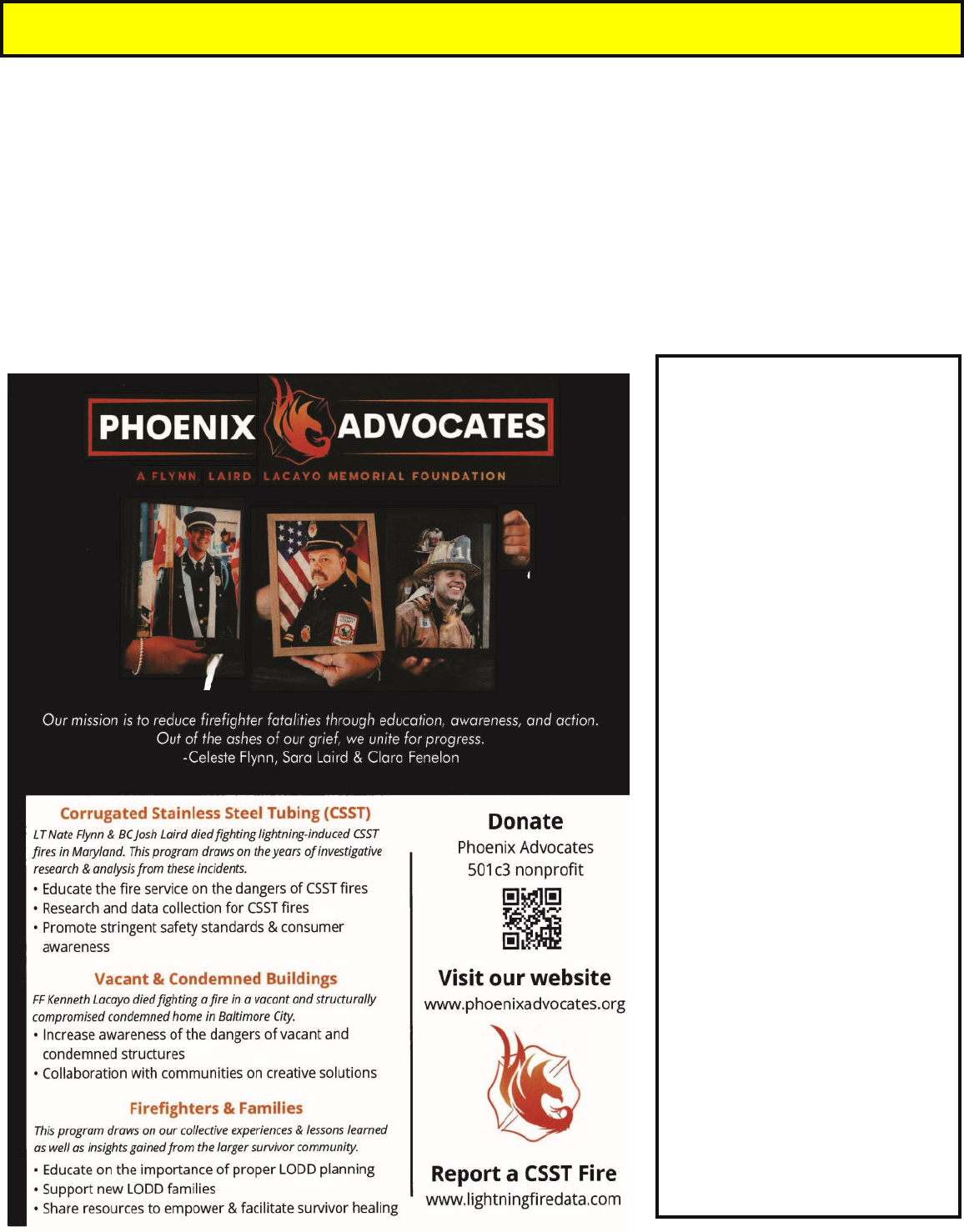
7. Add beans, legumes, and
vegetables to salads, soups, stir
fries, chili and stews.
8. Sprinkle ground flaxseed on
cereals, salads, grains, vegetable
dishes.
9. Add fruit and nuts to cereal,
salad, yogurt, or cottage cheese.
Due to the fact that the amount of
fiber varies in different plant foods,
it is important to eat a wide variety
of high fiber foods to maximize the
health benefits. The American
Heart Association recommends an
intake of 25-30 grams of fiber a day.
Use the % Daily Value (DV) to
identify a high or low fiber food.
20% DV or more dietary fiber per
serving is considered high. 5% DV
or less dietary fiber per serving is
considered low. Do your best to
include fiber with every snack and
meal.
Summarized and Written by:
Rhonda Cohen MFF, EMT, RDN,
LDN, CSN
Understanding Fiber: Health Benefits of a Fiber-Rich Diet
Try these energy bites for high fiber
snack on the go, to make you go.
Ingredients:
2 cups rolled oats
½ cup unsweetened coconut
¼ cup ground flaxseed
¾ cup peanut butter
½ cup honey or maple syrup
½ cup mini chocolate chips
Hand mix all ingredients in a bowl.
Scoop out one tablespoon of the
ingredients and roll into
approximately a one-inch ball.
Continue until all ingredients are
used. Store bites in a sealed
container and refrigerate until ready
to eat. If too sticky, add more
rolled oats.
Nutrition facts per serving
(one inch rolled bite):
Calories: 150
Fat: 7 grams
Saturated Fat: 2 grams
Fiber: 5 grams
Sugar: 9 grams
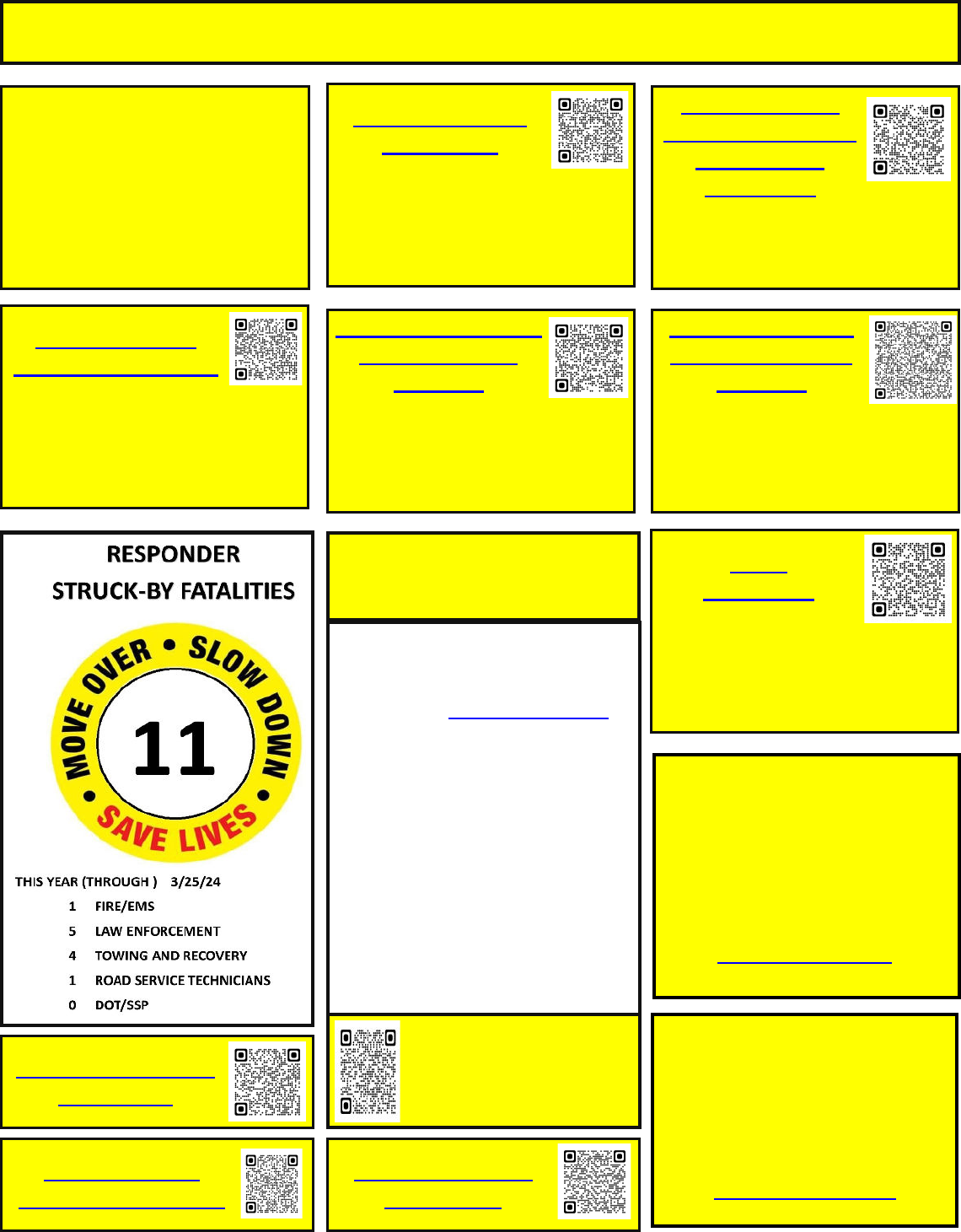
5
Firefighter Behavioral
The number of 1st responder
suicides through
March 31, 2024.
The number of fallen firefighters
through March 31, 2024.
15
US Fire Administration
Save the Dates
First Responder
Center for Excellence
Contact Us!
Email: [email protected]
Web Site:
www.mdchiefs.org
Chairman: David Lewis
Editor: Dick DeVore
Contributing Authors:
David Reid
Rhonda Cohen
Dave Black
Jon Johnson
John Long, Jr
Back Step Talks
Back Issues
Maryland Fire Chiefs
Association
Meeting
April 27, 2024
Kent Island Fire Department
Maryland Fire Chiefs
Association
National Volunteer
Fire Council
Women’s Weekend
at the National Fire
Academy
June 15-16, 2024
National Fire Academy
Emmitsburg, MD
Maryland Weekend at
the National Fire
Academy
June 8-9, 2024
National Fire Academy
Emmitsburg, MD
Eastern Division
International Assoc.
of Fire Chiefs
Conference
May 10-11, 2024
Mount Laurel, New Jersey
MFCA Spring Golf
Tournament
April 12, 2024
Oakmont Green Golf Course
Hampstead, MD
2024 MSFA & LA
Cancer Support Walk
April 28, 2024
MD Fire-Rescue Memorial
Annapolis, MD
MSFA
Convention
June 16-21, 2024
Ocean City Convention Center
Ocean City, MD
